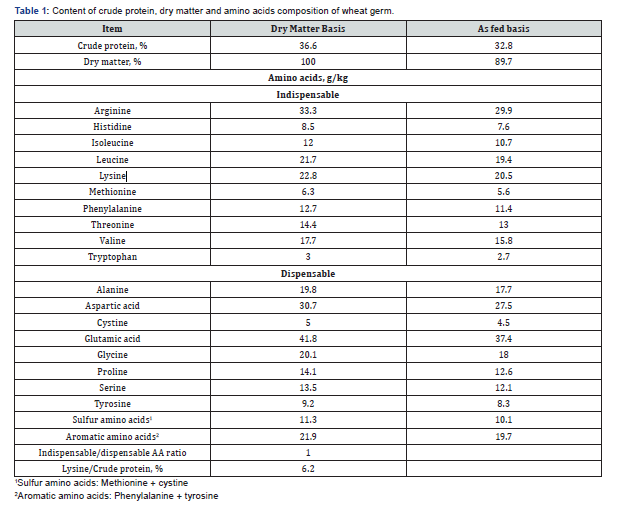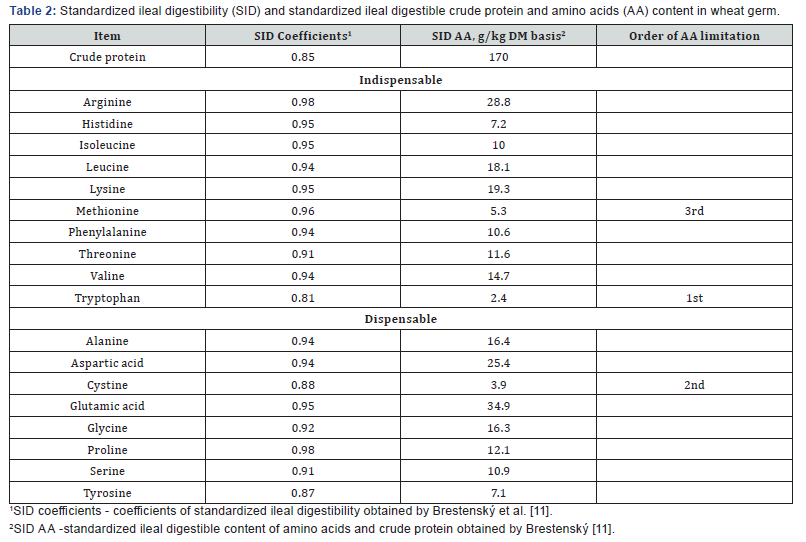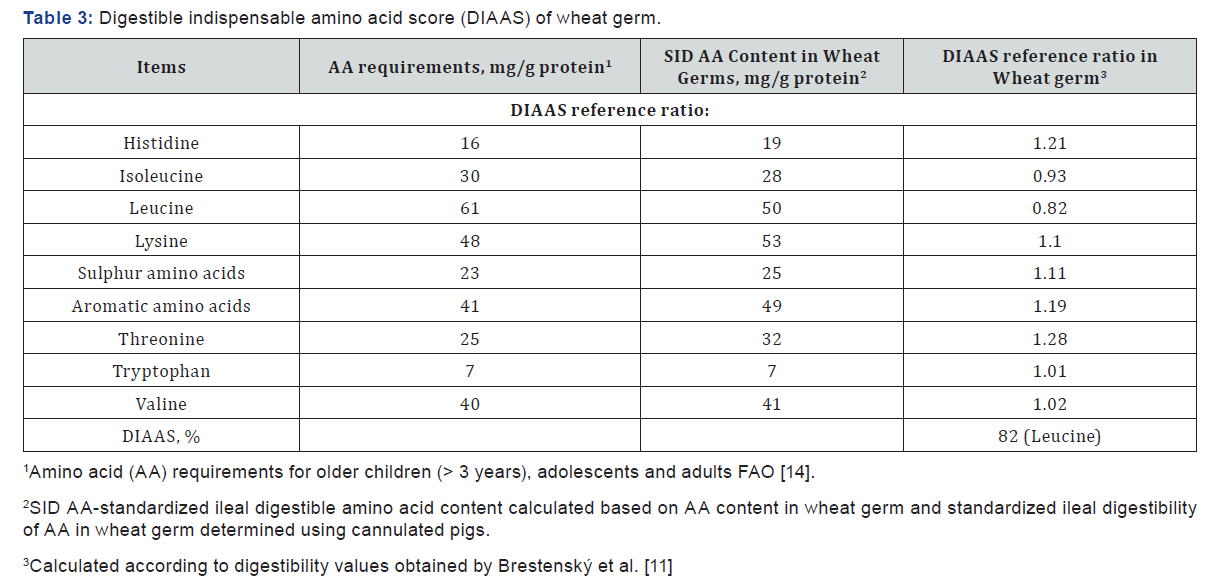Wheat Germs and their Protein Quality for Human Nutrition
Matej Brestenský1*, Soňa Nitrayová1 and Peter Patráš2
1TEKMAR SLOVENSKO, s.r.o., Slovakia
2Department of Nutrition, Research Institute of Animal Production Nitra, National Agricultural and Food Center , Slovakia
Submission: April 12, 2019; Published: May 06, 2019
*Corresponding author: Matej Brestenský, Department of Research and Development, TEKMAR SLOVENSKO, s.r.o., Vinárska 26, 951 41 Lužianky, Slovakia
How to cite this article: Matej Brestenský, Soňa Nitrayová, Peter Patráš. Wheat Germs and their Protein Quality for Human Nutrition. Nutri Food Sci Int J. 2019. 8(5): 555746. DOI:10.19080/NFSIJ.2019.08.555746.
Abstract
The wheat germs are by-product originating from milling industry. But there is a little information about protein quality of wheat germ as nutritional protein source in human nutrition. Therefore, this paper reveals the protein quality of this by-product. Wheat germs are rich in protein content which is about 36.5 %. Wheat germs are characterized by high standardized ileal digestibility of protein and amino acids. A digestible indispensable ileal amino acid score (DIAAS), as the lowest ratio between the content of standardized ileal digestible amino acid in the protein source and amino acid requirements for people, is 82 %. It is limited by leucine. Content of other amino acids, with exception of isoleucine, is in surplus. The DIAAS reference ratio for isoleucine is 0.93 and for the other amino acids is in a range from 1.01 (tryptophan) to 1.28 (threonine). The DIAAS reference ratio for sulfur amino acids is 1.11. In conclusion, wheat germs are a rich source of a high-quality protein, with a high ileal digestible amino acids content. Protein quality based on DIAAS is limited by leucine followed by isoleucine, but other amino acids are in surplus. By an inclusion of wheat germs in nutrition we can obtain new protein source while use the waste product of milling industry.
Keywords: Wheat germ; DIAAS; Protein quality; Human nutrition
Abbreviations: UTI: AA: Amino Acids; CP: Crude Protein; DIAAS: Digestible Indispensable Amino Acid Score; DM: Dry Matter; PDCAAS: Protein Digestible Amino Acid Score; SID: Standardized Ileal Digestibility.
Introduction
Nowadays about 1 billion people in the world suffer from malnutrition. In the next 35 years, a population growth on the planet, up to 9 or 10 billion people, there is expected, and this fact raises the question how to ensure the nutritional needs of the growing population [1]. The current protein sources are limited and constantly increasing worldwide population will result to increase the food consumption which will create a demand to find a new protein sources to satisfy the nutrient requirements for people. In comparison with animal, the plant protein is much more economical to produce. Plant proteins will be more and more consumed to the detriment of animal proteins. For a production the proteins of an animal origin a several times greater amounts of the vegetable protein are required and therefore, an increasing demand for the protein sources especially of animal origin will result for greater production of plant proteins [2]. The conventional plant protein sources, grains and seeds, are consumed by both humans and animals. One possibility how to satisfy the greater protein requirements in human nutrition is to find a new non-animal protein source. One possibility is the use by-products of the processing industry in food production [3].
The use by-products of the food industry in nutrition is a good alternative how to: 1) use a waste product of the food industry without having to throw away as useless, 2) obtain a new food or feed source for the human or animal nutrition. The by-products of the food industry can be divided to some categories concerning with the respect to their origin. For an example: the by-products of the sugar industry (broken beets or roots), by-products of the alcohol production and the fermentation industry, by-products of the brewer industry (malting sprouts), by-products of the fruits and vegetables (residues resulting from the production of juices) or by-products of the milling industry [4,5]. Many of these by-products are underutilized and are discarded as unused. On the other hand, there is a little information about the nutritive value of these by-products. Generally, their quality depends on the quality of the raw material and technologies and procedures for processing (e.g. high temperatures, pressure, etc.) [6].
The nutritional quality of the foods is characterized by their ability to ensure the nutrients (amino acids, saccharides, fatty acids, minerals, vitamins) into the body. The information on the nutrient composition as well as on the utilization of the nutrients from these products in body are limited. There is not easy to say which of these products are suitable for the nutrition from the different points of views (e.g. source of energy, fat or protein). Therefore, the protein quality of wheat germs, a by-product of the milling industry, as a potential nutritional source in human nutrition, is discussed in this paper.
Nutritional Characteristic of Wheat Germ from the Perspective of Protein and Amino Acids Content
A wheat germ is a by-product obtained by grinding the flour consisting of the wheat germ to which may be attached the parts of the endosperm and outer packaging layers. Wheat germ represents only 2 - 3% of the whole kernel [7] however, is a most nutritious part of the wheat kernel [8]. It has been reported that it is a good source of the vitamins, minerals and proteins as well. Despite the fact, that wheat germ is considered as a possible food ingredient [4] and their production in the world is high, however, the use of the wheat germ in the human nutrition is limited and to a greater extent it is used in the animal nutrition. Using the wheat germ in the human nutrition is also possible as an ingredient of some food products [9].
It has been reported that the wheat germ is a nutrient source with the high content of protein with well-balanced amino acid profile [10]. Wheat germ has only one half the glutamine and proline of flour, but the levels of alanine, arginine, asparagine, glycine, lysine and threonine are double (7). The content of protein in the wheat germ is about 36.5 %. Content of essential amino acids (Table 1) is in range from 3.01g/kg DM (tryptophan) to 33.3g/kg DM (arginine). Content of lysine and leucine is 22.8 and 21.7g/kg DM, respectively [11]. However, the protein quality is characterized not only based on protein and amino acid content but also based on amino acids utilization in body [12].

Amino acids enter the body through the wall of small intestine. Amino acids which are not absorbed in small intestine are subjected to microbial activity in upper parts of digestive tract. Therefore, the best criterion for amino acid digestibility is an ileal digestibility, which is measured as a difference between dietary amino acids and amino acids at the end of small intestine - ileum. Ileal digestibility corrected for basal endogenous losses (amino acids of endogenous origin: e.g. endogenous synthetized protein, compounds containing amino acids which are secreted to the lumen and are not absorbed) is standardized ileal digestibility (SID) which is the best criterion for amino acid digestibility [13]. The methods and approaches for protein quality evaluation in human nutrition were established [14]. The pigs surgically fitted with T-cannulas in a terminal ileum are used to determine the ileal digestibility of amino acids by reason that collection of samples an ileal digesta is necessary. Pigs are a good animal model for human nutrition and therefore, the results obtained from digestibility studies with pigs are also applicable in human nutrition [15-17].
Content of standardized ileal digestible amino acids represents the amount of amino acids in food component which is really digested and absorbed through the small intestine and pass into the body.
Content of standardized ileal digestible amino acids (SID AA) in food component is calculated as follows:
SID AA = content of individual amino acid in food component (g/kg DM basis) x coefficient of SID of the same amino acid
Content of SID crude protein in wheat germ is high (Table 2). Among the total amino acids, the greatest SID content is for glutamic acid followed by arginine and aspartic acid. Concerning the indispensable amino acids, the greatest SID content in wheat germ is for arginine, followed by lysine and leucine. Limiting amino acid, which amount is the lowest in the ingredient, may limit proteosynthesis [18,19]. In wheat germ, the tryptophan is first limiting, while the second one is cystine followed by methionine [11]. These amino acids are critical regarding the utilization of other amino acids.

Protein quality in wheat germ based on digestible indispensable amino acids score
In the past the protein quality assessment of foods in human nutrition was based on the protein digestibility corrected amino acid score (PDCAAS) [20]. Using this method, PDCAAS was calculated by multiplying the limiting amino acid score (i.e. the ratio of the first-limiting amino acid to the same amino acid of the reference protein) by true faecal protein digestibility. The digestibility coefficients were estimated in experiments on laboratory rats as differences between the ingested and excreted crude protein and were expressed as percentages of N ingested. But as was mentioned above, amino acids are absorbed in small intestine and amino acids in faeces do not correspond to dietary amino acids due to microbial activity in digestive tract. Therefore, this method was criticized and PDCAAS was replaced by new method - digestible indispensable amino acid score (DIAAS) [21]. When using DIAAS, the dietary amino acids are treated as individual nutrients and their digestibility rather than a single faecal protein digestibility is used in calculations. Several studies were performed which compared the PDCAAS and DIAAS method [22-24]. However, as was described above, best indicator for amino acid digestibility is standardized ileal digestibility which can be used for DIAAS calculation [21].
Protein quality expressed by DIAAS represents the ratio between digestible amino acid content in protein source and amino acid requirements for human and is calculated as the lowest ratio of ileal digestible amino acid concentration in the tested protein to the same amino acid in the reference protein [21] using following equations:
DIAAS reference ratio = 100 x ((mg of digestible indispensable dietary AA per 1 g of dietary protein) / (mg of the same dietary AA per 1 g of the reference protein))

DIAAS, % = 100 x lowest value of the DIAAS reference ratio
Protein quality in wheat germ based on DIAAS is limited by leucine. The value of DIAAS for leucine is 0,82 (Table 3). This means that content of SID leucine in wheat germ is only 82 % of its dietary requirements. Second limiting amino acid is isoleucine (92 % of its requirements). Other indispensable amino acids are in surplus to the dietary amino acids requirements, in the range from 101 % (tryptophan) to 128 % (threonine). Leucine and isoleucine are branched chain amino acids, together with valine. They are metabolized out of the liver in the skeletal muscle in which are oxidized and are important source of energy [25]. Especially, leucine is important because it stimulates protein synthesis and prevents breakdown of proteins after physical activity or during stress [26,27]. The recommended ratio Leucine: Isoleucine: Valine should be 2: 1: 1 [28]. Ratio of SID content for Leucine: Isoleucine: Valine in wheat germ is 2: 1.1: 1.6. However, the DIAAS of what germ is greater in comparison with cereal grains, e.g. DIAAS value for wheat is only 54 (lysine) [22] and for other cereal grains the reported DIAAS values were in the range 29 - 77 (lysine) [29]. The lysine was limited amino acid in all cereal grains.
When wheat germs are used in human nutrition, inclusion of any other protein sources rich in leucine and isoleucine (e.g. soybean, fish, milk) are necessary, to achieve balanced dietary amino acid pattern. For example, in soy protein the DIAAS reference ratio for leucine is 1.18 and for isoleucine is 1.39, in milk whey protein is 1.72 and 1.97 for leucine and isoleucine, respectively [30].
Conclusion
Wheat germs are food ingredient with a high content of protein and amino acids. Standardized ileal digestible amino acid content is the greatest for glutamic acid followed by aspartic acid and arginine. Concerning indispensable amino acids, the greatest standardized ileal digestible content is for arginine then for lysine. First limiting amino acid is tryptophan and methionine is the second one. Protein quality of wheat germs for human nutrition is expressed by DIAAS reference ratio. The value of DIAAS for wheat germ is 82 % (leucine). It means that the digestible leucine in wheat germs is in an amount of 82 % from its needs for human nutrition. The isoleucine is the second limiting amino acid. The content of isoleucine in the wheat germ is 93% of its human requirements. When wheat germs are used in human nutrition, leucine and isoleucine are necessary to supply for well-balanced dietary amino acid ratio. Other indispensable amino acids are in surplus when compared to their requirements.
Acknowledgment
This work was supported by the Slovak Research and Development Agency under the contract No. APVV-14-0515.
Conflict of interest
The authors declare that there is no conflict of interest associated with this publication.
References
- FAO (2011) The state of the world´s land and water resources for food and agriculture (SOLAW) - Managing systems at risks, Food and Agriculture Organization of United Nations, Rome and Earthscan, London, UK.
- Géhin B (2015) The world needs protein. Agro FOOD Industry Hi-Tech 26(2): 4-7.
- Mirzaei-Aghsaghali A, Maheri-Sis N (2008) Nutritive value of some agro-industrial by-products for ruminants - a review. World J Zool 3(2): 40-46.
- Herriatachy NS, Griffin VK, Gnanasambandam R (1996) Preparation and functional properties of a protein isolate from defatted wheat germ. Cereal Chem 73(3): 364-367.
- Fafiolu AO, Jegede AV, Oduguwa OO, Adebule MA (2016) Utilization of malted sorghum sprouts in the diet of pullet chicks. Pertanika J Trop Agric Sci 39(1): 17-27.
- Rausch KD, Belyea RL (2006) The future of coproducts from corn processing. Appl Biochem Biotechnol 128(1): 47-84.
- Cornell H (2003) The chemistry and biochemistry of wheat. In: Cauvain SP (Ed.), Bread Making: Improving Quality, Woodhead Publishing, Cambridge, United Kingdom, pp. 31-70.
- Haridas RP, Kumar GV, Rang-Rao GCP, Shurpalekar SR (1980) Studies on stabilization of wheat germ. Food Sci Tech 13: 302-307.
- Brandolini A, Hidalgo A (2011) Wheat germ: Not only a by-product. Int J Food Sci Nutr 63(Suppl): 71-74.
- Zhu KX, Zhou HM, Quian HF (2006) Proteins extracted from defatted wheat germ: nutritional and structural properties. Cereal Chem 83(1): 69-75.
- Brestenský M, Nitrayová S, Patráš P, Heger J (2013) Standardized ileal digestibilities of amino acids and nitrogen in rye, barley, soybean meal, malt sprouts, sorghum, wheat germ and broken rice fed to growing pigs. Anim Feed Sci Technol 186(1-2): 120-124.
- Millward DJ (1997) Human amino acid requirements. J Nutr 127(9): 1842-1846.
- Stein HH, Séve B, Fuller MF, Moughan PJ, De Lange CFM (2007) Invited review: Amino acid bioavailability and digestibility in pig feed ingredients: Terminology and application. J Anim Sci 85(1): 172-180.
- Lee WTK, Weisell R, Albert J, Tomé D, Kurpad AV, et al. (2016) Research approaches and methods for evaluating the protein quality of human foods proposed by an FAO expert working group in 2014. J Nutr 146(5): 929-932.
- https://www.ncbi.nlm.nih.gov/pubmed/23107536
- Moughan PJ, Ruthefurd SM (2012) Gut luminal endogenous protein: Implications for the determination of ileal amino acid digestibility in humans. Br J Nutr 108 (S2): S258-S263.
- Deglaire A, Bos C, Tomé D, Moughan PJ (2009) Ileal digestibility of dietary protein in the growing pig and adult human. Br J Nutr 102(12): 1752-1759.
- Rowan AM, Moughan PJ, Wilson MN, Maher K, Tamsa-Jones C (1994) Comparison of the ileal and faecal digestibility of dietary amino acids in adult humans and evaluation of the pig as a model animal for digestion studies in man. Br J Nutr 71(1): 29-42.
- Gorban AM, Pokidysheva LI, Smirnova EV, Tyukina TA (2011) Law of the minimum paradoxes. Bull Math Biol 73(9): 2013- 2044.
- Bender DA (2012) The metabolism of “surplus” amino acids. Br J Nutr 108(Suppl 2): S113-121.
- FAO (1991) Protein quality evaluation. Report of Joint FAO/WHO Expert Consultation. FAO Food and nutrition Paper 51. Food and Agriculture Organization, Rome, Italy.
- FAO (2013) Dietary protein quality evaluation in human nutrition. Report of an FAO Expert Consultation. FAO Food and Nutrition Paper 92, Food and Agriculture Organization, Rome, Italy.
- Mathai JK, Liu Y, Stein HH (2017) Values for digestible indispensable amino acid scores (DIAAS) for some dairy and plant proteins may better describe protein quality than values calculated using the concept for protein digestibility-corrected amino acid scores (PDCAAS). Br J Nutr 117(4): 490-499.
- Nitrayová S, Brestenský M, Patráš P (2018) Comparison of two methods of protein quality evaluation in rice, rye and barley as food protein sources in human nutrition. Potr S J F Sci 12(1): 762-766.
- Abelilla JJ, Liu Y, Stein HH (2018) Digestible indispensable amino acid score (DIAAS) and protein digestibility corrected amino acid score (PDCAAS) in oat protein concentrate measured in 20- to 30-kilogram pigs. J Sci Food Agric 98(1): 410-414.
- Shinnick FL, Harper AE (1976) Branched - chain amino acid oxidation by isolated rat tissue preparations. Biochim Biophys Acta 437(2): 477- 486.
- Harper AE, Miller RH, Block KP (1984) Branched-chain amino acid metabolism. Annu Rev Nutr 4: 409-454.
- Bolster DR, Jefferson LS, Kimball SR (2004) Regulation of protein synthesis associated with skeletal muscle hypertrophy by insulin-, amino acid- and exercise induced signaling. Proc Nutr Soc 63(2): 351- 356.
- Kurpad AV, Regan MM, Raj T, Gnanou JV (2006) Branched-chain amino acid requirements in healthy adult human subjects. J Nutr 136(1): 2565-2635.
- Cervantes-Pahm SK, Liu Y, Stein HH (2014) Digestible indispensable amino acid score and digestible amino acids in eight cereal grains. Br J Nutr 111: 1663-1672.
- Brestenský M, Nitrayová S, Patráš P, Nitray J (2018) Dietary requirements for proteins and amino acids in human nutrition. Curr Nutr Food Sci 14: 1-8.






























